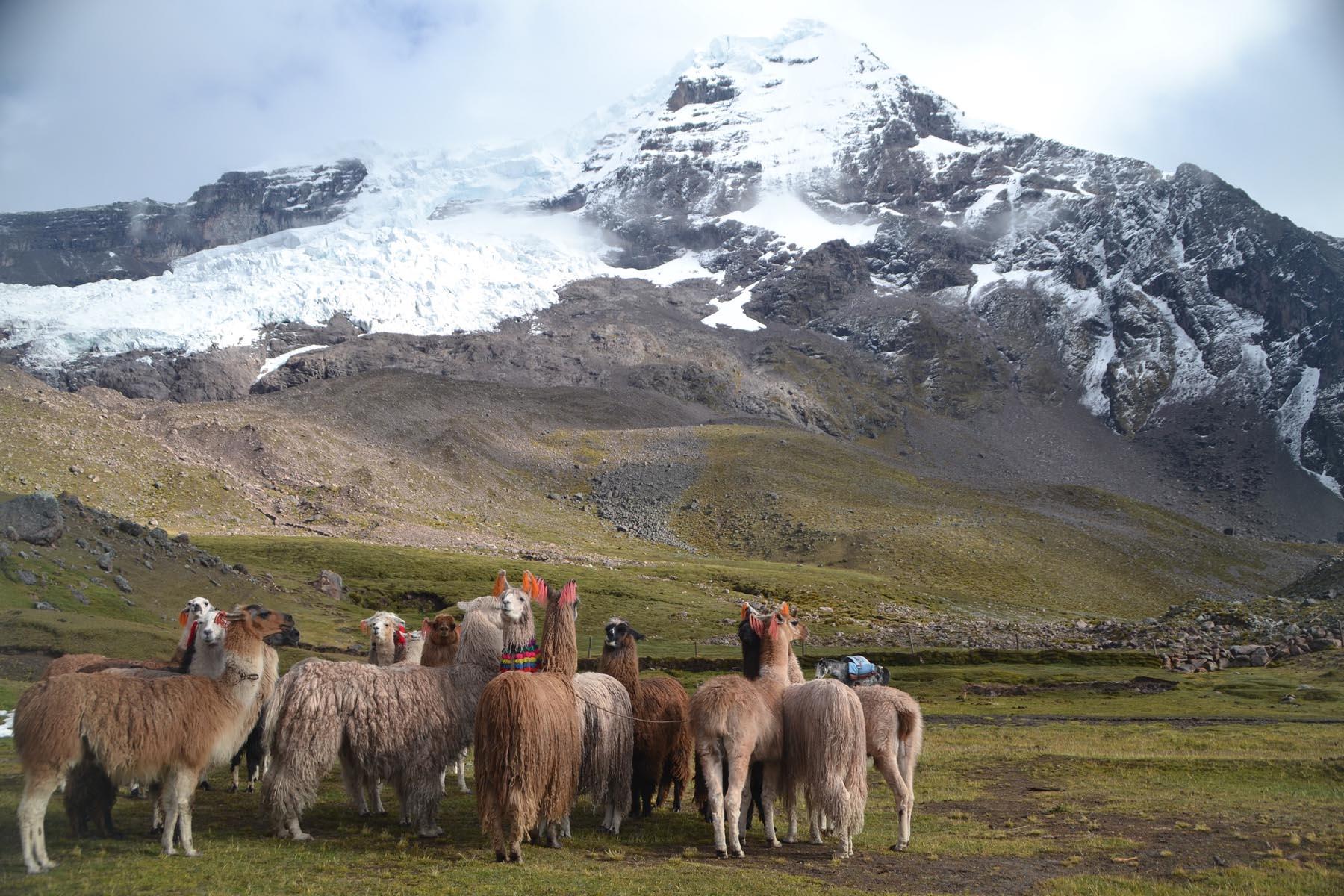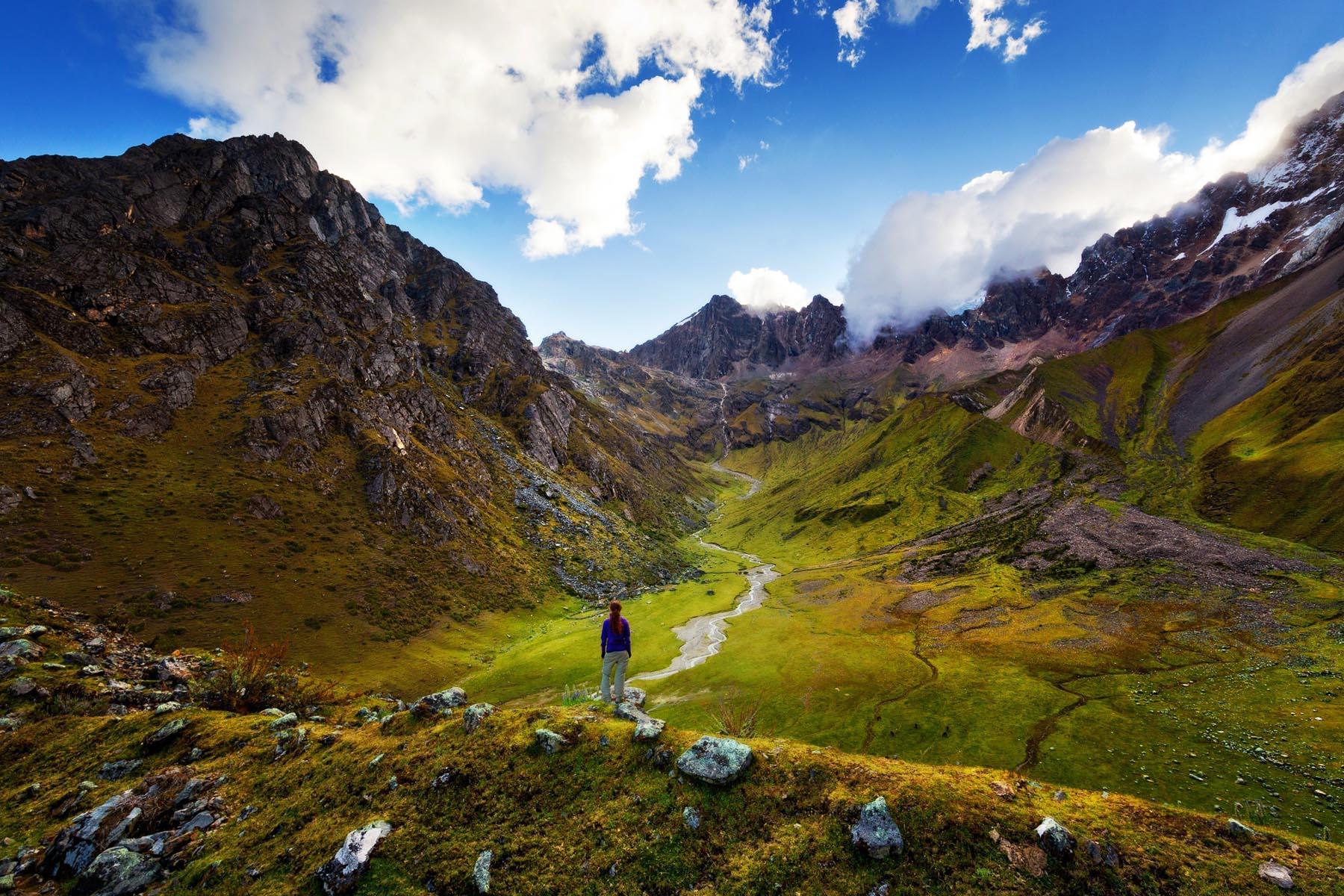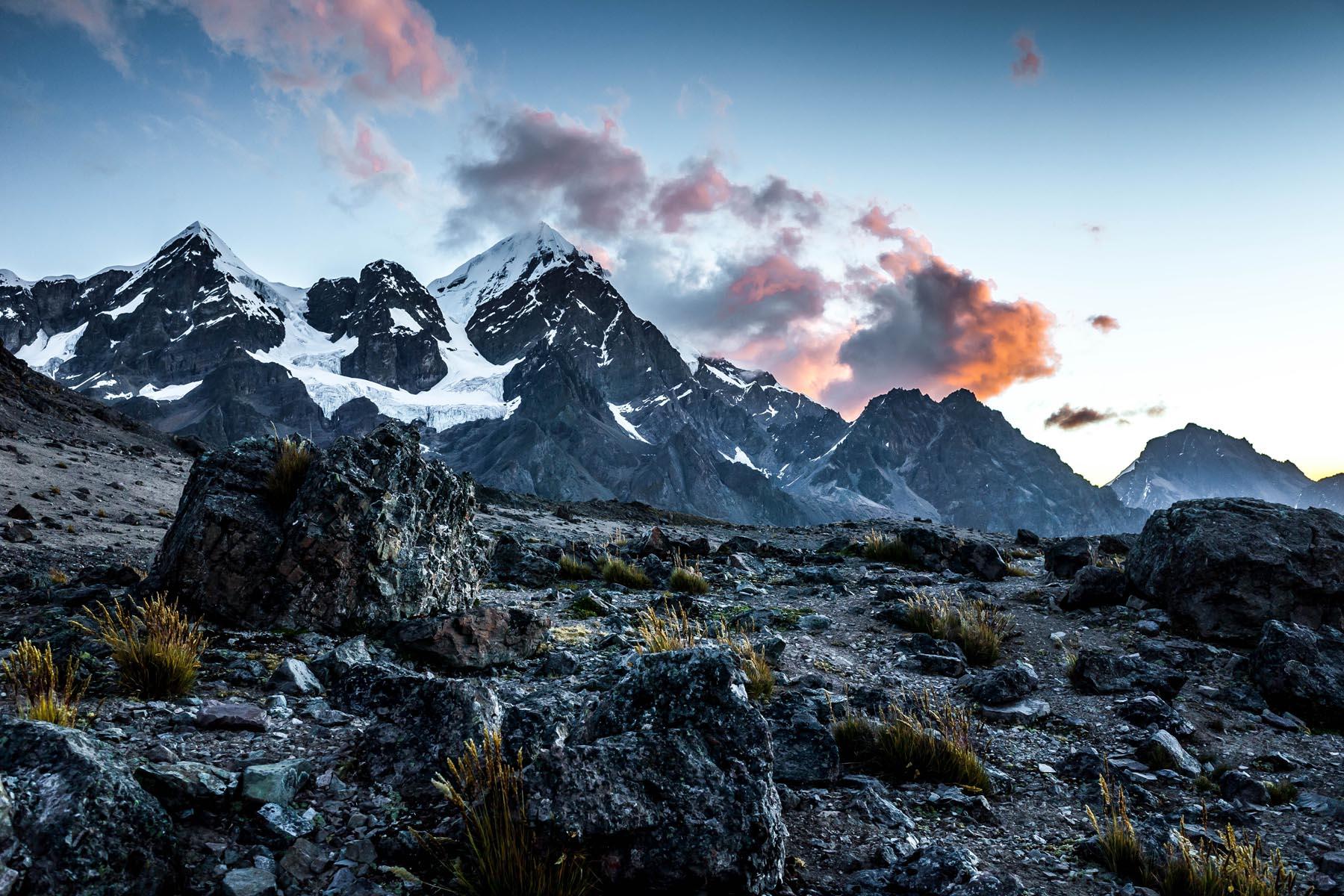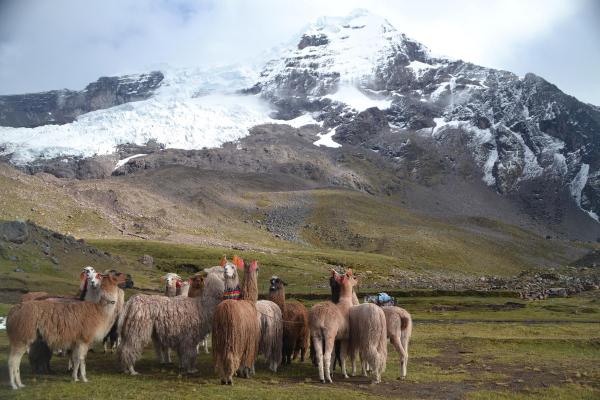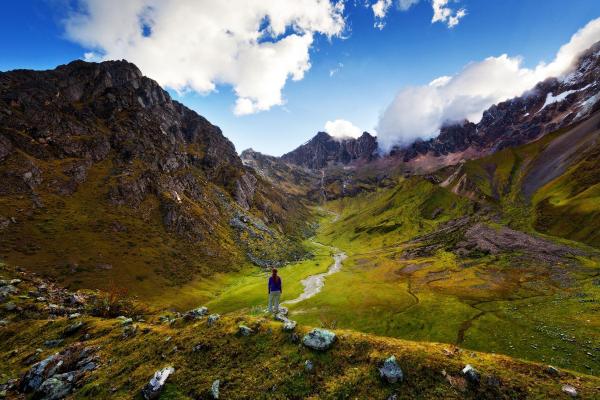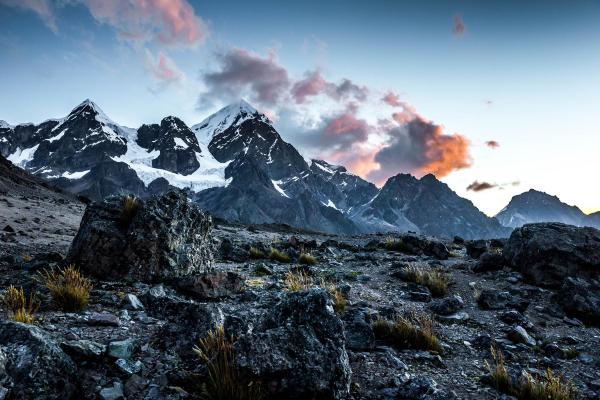Ausangate Peru Trek
$0.00/From
The trek to the snow-capped Ausangate, is one of the most exciting experiences in walking routes in the department of Cusco. This mountain is the highest in all the Vilcanota mountain range and is located at 6,392 m.a.s.l, on the route you can see beautiful lagoons of different colors, due to the minerals that exist throughout this area. The walk to the Ausangate snow is an indescribable adventure because of the impressive sunsets that make this trip unforgettable.The Ausangate mountain is located in the heart of the Vilcanota mountain range. It is one of the highest mountains in Peru. It is considered by many the most beautiful mountain in this part of the Andes. Although is located at 5 hours by car from Cusco, its snow-covered is visible from many parts of the city. The Ausangate Trek or Ausangate Hike offers a true wildlife experience, and is the most challenging hike offered in the Cusco region. This is a great walk for nature lovers, you can observe a lot of wildlife. The landscape in this part of Peru is very impressive: snow-capped white peaks and bright blue and green lagoons are just some of the scenic highlights. There is also a cultural element for this Ausangate trek, as it passes through several isolated Andean communities where the way of life has changed little since the reign of the Incas.During the time of the empire of the Incas, the Ausangate Meant one of the most important divinities for the people of that time. Its steep spurs and extreme walls of ice and rock made this mountain a true "unattainable God". Rating that lasts even these days; People who live in its surroundings consider it sacred and those who can approach during a trek or see the world from its summits discover the enigmatic charm of this six thousand located in the south of the city of Cusco, on the Vilcanota mountain range. An option for those who want to get away from the great masses of tourists in Cusco and ascend an Inca divinity of moderate difficulty. The tradition is still maintained: every year (Between May and June) the festival of Qoyllur Riti (star of the snows) is celebrated, which is an amalgam between the Catholic religion and the Andean ancestry. Thousands of pilgrims come to the foothills of the snowy Qolkke Punku, where the tradition indicates that large blocks of ice are carried home, not before passing through a rock where the figure of a Catholic Jesus is drawn at 4900 m. All under the tutelage of the "Apu" (sacred mountain). The Ausangate Trek is not as popular as the Inca Trail or the Salkantay Trek, but certainly a great option for the more experienced hiker with special interest in the nature and culture of Peru. The popular Rainbow Mountain or Vinicunca part of the Ausangate walk and is at the foot of the Ausangate.
Quick Itinerary:
- Day 01: Cusco - Ocongate - Tinki
- Day 02: Tinki - Upis - Hot Springs
- Day 03: Hot Springs - Pucaqocha Lagoon
- Day 04: Pucaqocha Lagoon - Palomani Pass - Jampa Valley
- Day 05: Jampa Valley - Pachaspata - Qomercocha Lagoon
- Day 06: Qomercocha Lagoon - Pacchanta
- Day 07: Pacchanta - Tinki - Cusco
Ausangate Tour Cusco:
Guardian of the Cusco region, Ausangate is the fifth highest mountain in Peru with its 6,384 meters of height. For centuries it has received many names, the best known being 'The Roof of the Inca Capital' and 'Vinicunca', which means 'Hill of Colors'. Located in the district of Pitumarca (in the province of Canchis - Cusco region, in the south of the country), Ausangate is considered the most important mountain of the Andean cosmovision. And although it is also one of the most beautiful, it is one of the least known abroad.During recent years, attempts to climb the Ausangate have increased, many of them by the normal route that runs on the south side and that is quite complex since it demands inclined climbs on ice. However, the mountain has been opened routes on all sides, all highly technical. Its name means "copper" in Quechua and is still considered a sacred mountain by local people. In fact, it is still one of the most important pilgrimage centers for the descendants of the Incas.
Location:
It is located in the mountain range of the Andes, in a section denominated Cordillera de Vilcanota, corresponding to the Cusco region in Peru. Its main peak is 6,384 meters above sea level with large lagoons with a bright green / blue color.
How to get?
The Vilcanota mountain range is led by the majestic Apu Ausangate which, with its 6,372 m. of altitude, it is often visible from the Sacsayhuaman fortress in the upper part of the city of Cusco. To get to the mountain range, it is necessary to take a bus or truck from Cusco to the town of Ocongate . From there, following the difficult road that arrives at Puerto Maldonado, you arrive at the town of Tinqui.The route to travel the eighty kilometers that includes the return to the Ausangate takes 7 days and it can be done walking or riding. The circuit has a series of attractions that make it one of the tourist areas with the greatest potential for trekking and climbing in Peru. The beautiful snow-capped mountains, the turquoise glacial lagoons, the ice caverns and the thermal waters add to the possibility of alternating with friendly and kind peasants of small hamlets. The route goes back two steps of height, one of 5.100 m.a.s.l., so it is necessary to have a previous and adequate acclimatization in the city of Cusco.
Agriculture and Livestock
The agriculture is intensive and concentrates on the production of a great variety of tubers, among which the oca and the potato stand out. Numerous animals as American camelids: llamas, vicuñas, alpacas, among others can be seen along the entire route, printing a unique touch in the local landscape.
Legends and traditions:
In the Inca mythology of this mountain and the nearby lakes among which Sibinacocha stands out the masculine energy that fertilizes Mother Earth Pachamama is born; After a long course, the waters are lost in the unknown lands of the Amazon to return, to fill the lakes and glaciers every night converted into the river of stars or Willkamayu known in the West as the Milky Way. The Community of Chillca constituted by shepherds of llamas and alpacas is known as the guardian of these pristine places, from where you can make mountain walks spending the night in comfortable hostels or tambos, among which Machuracay Tambo stand out, in a trek called " Path of the Apu Ausangate ". Every year on the north side of the Ausangate, the festival of Qoyllur Rit'i (Quechua: "star snow") has been held since time immemorial before the feast of Corpus Christi, during which thousands of Quechua pilgrims go to the Lord of Qoyllur Rit'i in the temple of Sinakara (painting done on a rock). This pilgrimage was included in the Representative List of the Intangible Cultural Heritage of Humanity.
Archaeological Sites between Vinicunca and Ausangate:
Colonial Bridge of Checacupe
Built in the 17th century, its structure is made of lime and stone, and it also forms the shape of a semicircular arch, mounted on its solid walls of natural rocks. The bridge is located on the Pitumarca river; adjacent to the bridge you can see the bases of an Inca bridge and another one of rails from the time of the republic. This bridge usually fulfilled its function, for many years giving way to the first engines that function with coal that arrived from Arequipa to Cusco.
Colonial Temple of Checacupe
Beautiful colonial monument built in the seventeenth century. Its construction is made of adobe and double water roof, also a square tower. Its interior is of a single nave, therefore the enclosure, both exterior and interior, presents remains of mural painting, therefore they have themes, such as the face of the Immaculate Virgin, which possesses Romantic and Byzantine evocations. Therefore they are, canvases belonging to the cusquenian pictorial school, also having Diego Quispe Tito as the main artist. According to some historians, the construction of this church takes 50 years. Its altar is made of fine carved wood and covered in delicate gold leaf. They usually highlight its numerous altarpieces of three bodies and three streets, of Renaissance style. This temple has the particularity, like owning the image of the Immaculate Conception, oldest of Cusco and probably of America. This image is of Romanesque style with Byzantine influences. Among other elements that stand out from the temple, there is the image of the Pieta, in the central niche of the altar, the image of San Miguel, with flaming sword in one of the beams, of the presbytery plus a carving of the communion rail, with the images, of the twelve apostles in golden wood, and polychrome.
Vinicunca
Vinicunca Peru mountain of colors, is a place located in the route of the Ausangate, therefore an obligatory stop, for the tourists by its charm, is inevitable; To get to the place you have to take mobility, from Pitumarca to the annex of Hamchipacha. In addition from this point it is part in walk, by the horseshoe road that lasts, approximately 3 to 4 hours.
Siwinaqocha
It is the 22nd highest lake in the world. So it is located in the Cusco Region of Canchis province, District of Pitumarca. The lake is located at a height of approximately 4,873 meters with about 15.19 kilometers long and 2.86 kilometers at its widest point. Laguna Siwinacocha is located in the Vilcanota mountain range, south of Chumpi and southwest of Kuntur Ikina.
Ausangate Lagoon
The Ausangate lagoon is at the foot of the Apu Ausangate (fourth highest mountain in Peru) (God tutelary in the Andean ideology) also its waters are fed by the waters coming from the snowy Ausangate; In this lake you can develop fishing activity as a sport.
Ananiso Canyon
The Ananiso Canyon is located 24 km from the district of Pitumarca, whose depth is 150 meters high, the tourist activities that can be done are sport fishing, as well as observations of birds such as the huallata camelids like the alpaca, geological formations from the tertiary era, until the present time and the biodiversity in Andean plants like the Qeuña.
Rock Climbing - Huayllasqa
In order to reach the climbing area, we take a ride that takes us to Huayllasqa, which lasts approximately 15 minutes from the town of Pitumarca, the road revealed an impressive landscape: full of huge walls, which challenge climbers with an impressive texture. At first glance, the enormous potential of the area for all types of climbing was noticeable.
Thermal Baths of Uchullucllo
It is located at an altitude of 4000 m.a.s.l whose temperature is 26 ° C. is located approximately 30 kilometers from the town of Pitumarca. These thermal waters serve to heal muscular pains, for polyarthritis, rheumatism, arthritis, traumatisms and joint pains
INTERESTING INFO:
- Short Salkantay Trek
- Cachicata to Machu Picchu
- Rainbow Mountain Trek
- Southern Valley Tour
- Lares trek to Machu Picchu
Tour Plan
Day 1: Cusco - Ocongate - Tinki
We leave the city of Cusco in the morning and take the local bus and will drive along the Cusco - Puerto Maldonado towards Tinki (3,800m / 12,467ft). On the way we will stop at Urcos to take some pictures of the colorful market. In continuation we will go to Cattca, an agricultural and livestock community, where we can enjoy a spectacular view of the region. After passing through Ausangate, the capital of the region, we arrived in Tinki after about six hours on the bus. In Tinki, we slept in a local shelter and started the walk the next morning.
Day 2: Tinki - Upis - Hot Springs
After our delicious breakfast, we will go away from the town of Tinki starting the walk along the Ocongate river and we will start to cross the puna (mountain meadows), until we reach the foot of the Ausangate mountain. From here we have an impressive view of the beautiful peaks of mountain which makes our trip more extraordinary. We continue to the town of Upis to enjoy the thermal baths is a great place to relax after the rigors of the day.
Day 3: Hot Springs - Pucaqocha Lagoon
After breakfast we will start a continuous ascent until you reach the Abra Arapa (4,850 meters / 15,912 feet). In the afternoon, continue through the valley, passing the green Puqa Q'ocha Lake and arriving at the turquoise-colored Jatun Puqa Q'ocha (4,800 meters / 15,748 feet), where the camp will be set up for the night. Once in the camp, you have the option of climbing a small ridge north of the camp to see the Vino Q'ocha Lake. The locals gave that name to the lake because sometimes the lake is dyed a reddish color by the glacial sediment that comes down from the nearby reddish mountains. Sometimes you can hear the disturbing sound of a piece of ice falling off a nearby glacier and falling into the water. The total distance you will cover during your trek today is approximately 13 kilometers (8 miles), which equates to approximately six to seven hours of walking.On the way we can see magnificent landscapes and different Andean birds.
Day 4: Pucaqocha Lagoon - Palomani Pass - Jampa Valley
In the morning you will ascend to the second pass of Apuchata (4,900 meters). From the opening you can see the Ausangate Lake with its turquoise color, which is fed with melting snow from the Ausangate. You will descend to the lake and climb again to reach the Palomani Pass (5,200 meters / 17,060 feet), the highest point of the walk. You will follow the path that will take you to the next valley for approximately one hour to reach Pampacancha (4,500 meters / 14,763 feet),and finally Jampa valley the night camp site. The total distance you will cover during your trek today is approximately 14 kilometers (8.7 miles), which equates to approximately seven to eight hours of walking.
Day 5: Jampa Valley - Pachaspata - Qomercocha Lagoon
Compared to the previous days, today will be relatively easy. During the walk, the snow-capped peaks of Tres Picos and Puca Punta will appear. The path between the wide green valley of Pampa Jutunpata and the valley of the Q'ampa River are also excellent places to see the charming vizcacha, a small rodent that looks like a cross between a squirrel and a rabbit and lives in large family groups. You might also be lucky enough to observe groups of vicuñas, without doubt the most beautiful member of the llama family, with its slender neck, huge eyes and soft golden wool. After passing through the small community of Q'ampa, the trail continues northwest to reach the final stretch of this hike, the Abra Q'ampa (5,000 meters / 16,404 feet). From above you can appreciate several lakes of different colors. You will descend to Lake Q'omer Q'ocha where the camp will be set up for the night. The total distance you will cover during your trek today is approximately 14 kilometers (8.7 miles), which is equivalent to approximately six hours of walking.
Day 6: Qomercocha Lagoon - Pacchanta
Another relatively easy day; today we will walk until arriving at the small Andean town of Pacchanta. You will have the opportunity to rest and relax in the thermal baths and spend a few hours in this interesting Andean town. The total distance you will cover during your trek today is approximately 12 kilometers (7.5 miles), which equates to approximately three to four hours of walking.
Day 7: Pacchanta - Tinki - Cusco
After breakfast you will walk to Tinqui from where you will be transferred to Cusco in a trip of approximately 3 hours.
Included & Excluded
Details about services not included and details not included in our packages, if you have any questions please contact us.
- Pre-trek briefing a day before with your Tour Guide.
- Transfer by private vehicle to Tinki - the initial point of the trek.
- Accommodation: Campsites (6 nights).
- Meals: 6x breakfast, 6x lunch, 6x dinner and 6x afternoon hot beverages (Please advice us in advance if you are a vegetarian; this option is for NO extra additional cost).
- Professional bilingual Tour Guide.
- Professional Cook.
- A Horseman.
- Horses to carry food, camping and cooking equipment and 7 kg of each passenger's belongings.
- Camping equipment: personal double tents, sleeping foam matts, tables and chairs, a cooking tent with cooking equipment, dining and toilet tents and bottled gas.
- Food.
- A sleeping bag (for up to -5°C).
- Return transport from Tinki to Cusco.
- Breakfast on the day 1 and lunch on the last day.
- International and domestic flights nor airport departure taxes.
- Travel insurance.
- Tips to local staff (please note: it is a custom to give tips in Peru; however, it is not obligatory).
- Other extras not mentioned.
PLEASE BRING WITH YOU:
- Plastic to cover your bag
- Poncho,waterproof raincoat jaket
- Good hiking shoes
- Insect repellent
- Snaks: Candies, Chocolates
- Warm sweater
- Coats
- Hat
- Bottles with water and pills to purify the water (very important)
- Sunscreen
- Dried fruit and cookies
- Sunglasses
- Camera
- Batteries
- Personal medication
- Lantern
- Warm clothes





